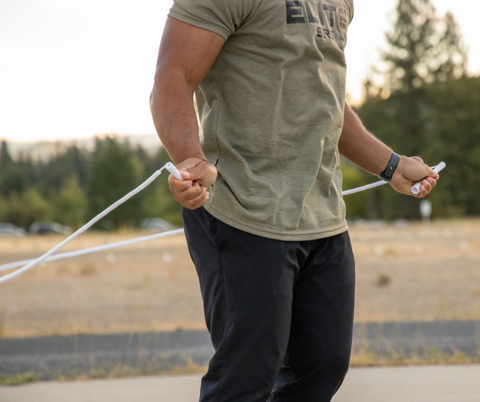Mastering Double Unders: How to Find Your Rhythm
Jul 16, 2021Dan Cox

Timing is everything in jump rope, and mastering rope control will give you complete control over your rhythm. If you are struggling with the timing for double unders it is important to simplify the movement in order to isolate its different elements.
In this article, we will identify where you want the rope to be when you start your jump, walk through three basic exercises for practicing rhythm, and explain a common phrase used in jump rope, called “jump rope feedback.”
To best illustrate when you want to jump and speed up your rope, imagine a clock around your body. Your head is 12 o’clock and your feet are 6 o’clock. You want to aim for the rope to be at 3 o’clock when you start your jump. If you start jumping too soon, you will likely miss your second rotation or need to overcompensate by jumping much higher than needed. If you start your jump too late, the rope will make contact with the floor too far in front of your feet and bounce back up at you, causing a miss.
If you listen to the sound of the rope during double unders, you’ll hear a distinct rhythm: two fast “swishing” sounds, followed by a slight pause (1,2,---,1,2,---,etc.) The slight pause allows time for the jumper to land the first double under and jump again before the rope speeds up for the next double under. This rhythm is an essential component of successful double unders, so you’ll see it emphasized in each of our practice drills below.
First, try the “Penguin Jump.” Start without a jump rope in your hands and slap your thighs twice with each jump. See if you can feel and count the “1,2,---,1,2,---” rhythm as you slap your thighs. Yes, it will feel and look a bit awkward, but you will be able to easily sense the height needed for each double under and the speed at which the rope needs to rotate.
Once you have successfully embarrassed yourself with the penguin jump, you can progress to jumping with a rope. But instead of attempting a double under, continue jumping the same height you would for a double under with only one rope rotation. This will allow you to sense where the rope is and slow down the overall movement before needing to speed up your hands. This drill specifically targets the pause between double unders (the --- in our 1,2,--- rhythm).
Once your body is used to slowing the rope down between jumps, you can then work on increasing your rope speed. We recommend first working on speed with the cordless jump rope. The cordless rope will allow you to practice the complete movement and feel the speed of the rope without the risk of errors. As you practice, try counting our 1,2,--- rhythm in your head and matching it with the cordless rope.
A common term used in jump rope training and tutorials is feedback. Feedback is the sense of where the rope is in its rotation while you are jumping. Generally, the thicker the rope, the greater the resistance will be as the rope moves through the air. As resistance increases, feedback increases. To successfully complete double unders, feedback is a helpful tool when getting started until the movement has become muscle memory.
For that reason, we recommend beginners start with a thicker cord or cable, such as the Motion Series: 4mm PVC Cord in order to increase the feedback they receive from the rope and expedite their learning. Once you feel comfortable controlling that rope, you can try gradually moving toward thinner and thinner cables for more efficient double unders.
More from our Double Under Mastery Series:
We're all about equipping and encouraging people to take on big challenges, because we know the process of doing hard things helps us grow in character and capacity.
Frequently bought together
You may also like
0 Comments
There are no comments for this article. Be the first one to leave a message!